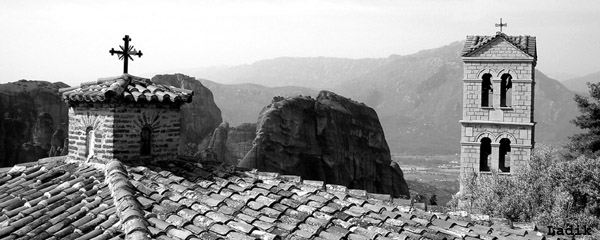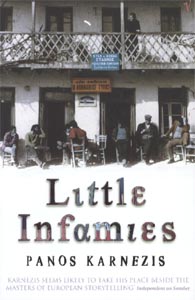
photo by Ladik
by Gina Challen
I like stories that are alive – stories with a heartbeat I can feel beneath the words. I don’t mind whether it’s realist, fantastic or sci-fi. I’m not snobby about genre. I only want to believe that these things happened to these people in this place. I want to accept the truth of the story, if only for a short while.
It’s very easy to accept the truth of the stories in Panos Karnezis’ Little Infamies, a collection of nineteen gently interlinking tales, all set in a fictional village in rural Greece. Each could be read individually, but there is much to be gained from reading the collection as a whole, as protagonists from one tale become ‘bit players’ in another. Gradually I recognised not only the characters of the village but also the important landmarks: the village square, the church and the café. This growing sense of familiarity draws the reader into Karnezis’ world and, once caught, it’s very difficult to leave.
Karnezis has a no-nonsense writing style that is, paradoxically, very descriptive; it is at times surreal, yet believable. Ordinary life walks beside strange happenings. He draws heavily on his Greek heritage, effortlessly blending mythology with folk homilies and realism, to weave narratives reminiscent of the best folk tales. I was interested to note that when asked about his motivation to write fiction, Karnezis said, “For me, writing was as much an outlet for my nostalgia as it was my creative urge.” However, his nostalgia is certainly not for a romanticised land of sun, olives and honey. Rather, Karnezis writes with great honesty about the fallibility of his characters; about their minor scandals as well as their atrocities.
He draws heavily on his Greek heritage, effortlessly blending mythology with folk homilies and realism, to weave narratives reminiscent of the best folk tales. I was interested to note that when asked about his motivation to write fiction, Karnezis said, “For me, writing was as much an outlet for my nostalgia as it was my creative urge.” However, his nostalgia is certainly not for a romanticised land of sun, olives and honey. Rather, Karnezis writes with great honesty about the fallibility of his characters; about their minor scandals as well as their atrocities.
The first story, ‘A Funeral of Stones’, sets the apocalyptic tone for the collection when an earthquake exposes a small coffin full of stones. This discovery reveals so much more than the sad life of the widower Nikiforo – it lays bare the collective morality of the village. This revelation, in turn, draws the reader into ‘a sinister yet delicious secret shared by everyone in the village apart from the priest, the doctor and the civil guardsman’. As I continued to read, I discovered more secrets, such as Whale’s unrequited love in ‘Whale on the Beach’, and the poisoned suppositories Doctor Panteleon makes in ‘Medical Ethics’.
With each new reveal, Karnezis pulls us deeper into the soul of the village. We become honorary villagers, sharing the gossip and judging our neighbours. The villagers live a harsh life, but Karnezis evokes a wistfulness and longing for a strong community. Herein lies the dexterity of his prose, and, thankfully, it’s not all bleak. A thread of romanticism runs through many of the stories, along with a wry sense of humour, both of which he exploits with a deft sleight of hand in a ‘now you see it now you don’t’ style.
Much of the skill in these stories belongs to Karnezis’ creation of unique characters, both human and animal, that linger in the memory long after the stories are finished. It’s hard to overlook a disgruntled centaur, although, of course, in Karnezis’ village he’s not special, he’s ‘only a horse who can talk’. It’s difficult to ignore a parrot called Homer who ‘appreciates the dactylic hexameter’. And even harder to forget are lines such as this, which spills from the mouth of the village priest: ‘“Shit!” he uttered. “It’s the Second Coming.’”
Father Yerasimo is a constant who walks through many of the tales, urging his flock to repent of their sins, and trying desperately, by fair means or foul, to force them to follow the path of God. The stories become a form of a confessional for the characters, but Karnezis uses the reader, rather than this flawed man of God, as the true confidant. Perhaps we will be more forgiving and understanding.
In Little Infamies, the story ‘The Hunters in Winter’ stands out for its uncompromising sense of desolation. It is the only story with a first-person viewpoint, and it tells of a group of lost hunters who terrorise the village and whose brief stay culminates in the burning of houses and the raping of the young girls. This makes for wretched reading. Gone is the tongue-in-cheek humour. Instead we see Karnezis’ straightforward tone amplified by anguish and despair. Reading it, I felt as if Karnezis had looked up from his writing, slapped me once around the face, and then carried on unperturbed:
“What are you going to do to us?”
We pushed a barrel to where we stood and lit a fire with their clothes. It warmed us up until it was our turn to go into the houses. The stoves were lit there, the food was cooked, there was wine. These people were poor, but we still wished we had beds like theirs to lie in every now and then.
“Please, don’t,” the mothers cried. “They’re only little girls.”
 This story brings me back to the benefit of reading the collection as a whole. It sits between ‘Sacrifice’, a story of a young boy’s rite of passage as he kills the bull that murdered his sister, and ‘Applied Aeronautics’, in which a man confronts the failure of his ambition to fly with turkey feathers and candle wax. (As I mentioned, these stories are rooted firmly in mythology). The positioning of ‘The Hunters in Winter’ serves to highlight the vulnerability of the people and their isolation from a larger social structure. A boy can conquer a domestic beast, and a man may one day realise his dreams, if he remembers ‘that turkeys can’t fly’, but no one can fight the enormity of an attack from the outside.
This story brings me back to the benefit of reading the collection as a whole. It sits between ‘Sacrifice’, a story of a young boy’s rite of passage as he kills the bull that murdered his sister, and ‘Applied Aeronautics’, in which a man confronts the failure of his ambition to fly with turkey feathers and candle wax. (As I mentioned, these stories are rooted firmly in mythology). The positioning of ‘The Hunters in Winter’ serves to highlight the vulnerability of the people and their isolation from a larger social structure. A boy can conquer a domestic beast, and a man may one day realise his dreams, if he remembers ‘that turkeys can’t fly’, but no one can fight the enormity of an attack from the outside.
I can feel the heartbeat in this collection; there is life in every one of the tales. Karnezis’ touch is light yet no one could doubt his compassion and empathy. Indeed, it is something we feel all the more keenly because there’s no melodrama in the prose.
For me, Karnezis achieves a small literary miracle. The realist, poignant detail that is Chekhov’s legacy walks side by side with Kafka-esque forays into the fantastic. As a writer, I can learn a lot from this skilful melding of imaginative daring and down-to-earth prose. As a reader, I value the sense of belonging afforded me by the world of Karnezis’ village – I won’t be moving in, but I definitely enjoy the visits.


Thanks for your review, Gina, really enjoyed reading it. I will have to buy this collection, if only to find out more about the stone-filled coffin. Very intriguing!